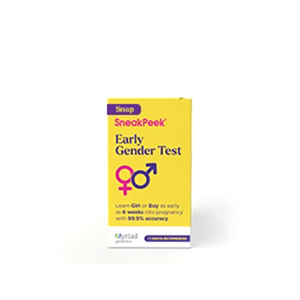Published on June 26th, 2023 and Updated on January 15th, 2024
Check out SneakPeek Gender Test to find out your baby’s gender as early as 6 weeks at over 99% accuracy1!
Paternity testing methods have been used for decades by women and parents who want to establish the biological parentage of their children. But with recent advancements in the field of genetic testing, today’s highly accurate DNA-based paternity tests have made it even easier to determine who a child’s parents are—both after and during pregnancy.
DNA-based paternity tests assess fetal DNA available in the mother’s bloodstream to determine the likelihood of paternity. While a prenatal paternity DNA test can’t be used to draft a list of all potential fathers, it can be useful for confirming or excluding a suspected candidate.
There are many reasons why you might take a prenatal DNA paternity test during pregnancy, but it’s not always clear how they work. If you’re considering undergoing a prenatal paternity DNA test, this guide will introduce you to paternity testing options, as well as what to expect from the process.
Should I get a paternity test while pregnant?
Deciding to take a prenatal DNA paternity test can feel like a highly personal, and sometimes emotional, decision. Any trepidation or complicated feelings you or your partner(s) may have are entirely normal—and it’s equally normal to not have complicated feelings at all!
Regardless of your circumstances, understanding the objective uses and potential benefits of paternity testing may help you come to a decision about whether it’s right for you. Plenty of women elect to undergo testing for the following reasons:
- To support co-parenting or future family dynamics – These days, it’s common for family arrangements to look different from the traditional structures of yesteryear. Whether you’ve already decided on how you’ll raise your child or you think family dynamics might shift over time, knowing your child’s biological parentage may help you start your unique parenthood journey with a sense of security.
- To establish financial responsibility – If you intend to seek child support from your child’s father, you’ll need to certify his genetic relationship to your baby (if you’re unsure). In the US, both parents are obliged to financially support their biological child even if they aren’t legally married.
- To gain insight into their child’s health – Genetic testing is most commonly used to screen babies for chromosomal or genetic disorders. Knowing where the other half of your baby’s DNA came from can help shed light on whether they’re at risk for any health conditions passed down from their father.
- To determine whether or not to continue with a pregnancy – In some cases, women decide to pursue paternity testing to help them come to a decision about whether or not to have their baby.
- To comply with state laws – Some states require a paternity test to establish who a baby’s father is so that their name can be added to the child’s birth certificate.
Finally, many women seek out paternity testing to reinforce the parent-child relationship. It’s well known that babies and their mothers go through a profound biochemical bonding process, starting from the womb and continuing long after a pregnancy is over (thank you, oxytocin!).
However, research is still being conducted on the biochemistry of father-baby bonding: some studies suggest that perinatal bonding exists between biological dads and their future babies. Others indicate that the same type of chemical connection mothers have with their children isn’t in play with fathers. This may be especially true if family dynamics are more complex, or if a father and child don’t spend a lot of time together.
While science has yet to reach a verdict on whether father-child bonds originate biochemically, many expecting moms feel that establishing their baby’s genetic parentage can help lay the foundation (or offer the potential) for a healthy connection between a father and their future child. In other words, genetic testing can be a useful tool in resolving one of the many question marks involved in pregnancy—even if you don’t know what the future looks like just yet.
Types of Paternity Tests Available While Pregnant
Before recent advancements in the field of genetic testing, paternity was determined after a child was born using the ABO blood group typing. This modality examines a child’s blood to screen for certain antigens, which are genetically determined according to biological parentage.
While the ABO blood test method is still an option, today’s genetic paternity testing delivers far more accurate results and can be conducted before a child is born. There are two main types of prenatal paternity testing available: non-invasive and invasive.
Non-Invasive Prenatal Paternity Tests (NIPPs)
An NIPP provides over 99% accurate results and can be administered as early as 8 or 9 weeks into a pregnancy, with results delivered in as few as 2 days. It’s a relatively simple NIPT procedure that involves two main actions:
- Screening fetal DNA – The pregnant mother will give a small sample of blood, which contains fetal cells. These are then screened by a healthcare provider or mailed to a lab to have the baby’s DNA analyzed.
- Screening potential paternal DNA – The potential father will provide a sample of DNA—either a cheek swab or a blood sample. The DNA present in those cells will then be compared with the fetal DNA sample.
Bear in mind that paternity tests must be taken with the cooperation of the suspected father. If the labs detect a DNA “match,” then the tested party is considered the father of the child.
Invasive Prenatal Paternity Tests
Invasive prenatal paternity testing involves taking a tissue sample that contains a baby’s DNA, which may then be screened for the probability of paternity.
The most common non-invasive prenatal paternity tests include:
- Chorionic villus sampling (CVS) – CVS is traditionally used as a part of prenatal testing to screen for chromosomal abnormalities or DNA-based illness, but it can also be used to determine the probability of paternity. In this procedure, a sample is taken from the placenta using a catheter or needle and then sent to a lab for analysis. CVS can be performed between 10 and 13 weeks after a woman’s last menstrual cycle.
- Amniocentesis – Amniocentesis is similar to CVS, but it involves taking a sample of amniotic fluid (rather than the placenta itself). The procedure can be administered 15 to 20 weeks after a woman’s last period.
Both CVS and amniocentesis can be just as accurate as NIPPs, but bear in mind that they carry a slightly elevated risk of pregnancy loss.
How much does paternity testing cost?
Prenatal paternity testing can be expensive, typically costing between $900 and $2,000. This is because the laboratory process involved with separating a fetus’ DNA from its mother’s tends to be a highly involved and costly procedure. Fortunately, many providers offer pursuants payment plans to help distribute the expense.
If you wait until after your baby is born, expenses decline significantly. Post-pregnancy paternity testing, including at-home tests, tends to cost between $60 and $200.
If you’re pursuing paternity testing under an ordinance of the court, and are obliged to have the test performed by a certified medical provider, you may find this adds extra costs to the testing process.
Is paternity testing covered by insurance?
Unfortunately, paternity testing isn’t covered by insurance.
Can paternity tests be ordered online?
In many cases, yes. However, some US states place restrictions on paternity testing to protect all parties involved. For instance, people who live in New York may need to secure authorization from a registered doctor or lawyer in order to test and have their results officiated.
If you’re unsure about your local restrictions, it’s best to do some research on your state laws regarding paternity. Just bear in mind that potential parents living in different states may need to reconcile their respective legal terms if their states have conflicting laws.
How to choose a prenatal paternity test?
Paternity tests are widely available online, though not every genetics testing firm in the marketplace is equally credible. If you’re just starting to look for a prenatal paternity test, keep an eye out for:
- Solid privacy protections – Every paternity test vendor has its own policies regarding user privacy. Ideally, you’ll want to find a company that pledges to only use your provided sample for the purposes of the services you’ve requested upon purchase. You may also want to find a clause that awards you the right to withdraw consent at any point in the process.
- Legality – The majority of at-home paternity tests aren’t considered legitimate in the eyes of the court. A rare few may be considered legally admissible, but you’ll need a witness to make their results legitimate.
Get Results You Can Trust with SneakPeek
Make no mistake—the process of paternity testing, whether during or after pregnancy, can be interpersonally and legally complicated. Fortunately, the more progress we make in the field of genetics, the simpler and more convenient the testing process itself becomes.
If you’re an expecting mom who wants to learn even more about her future baby, check out SneakPeek’s Early Gender DNA Test. With this at-home DNA-based gender blood test kit, you can discover your baby’s gender with over 99% clinically proven accuracy1 as early as 6 weeks into your pregnancy journey.
Our SneakPeek Test labs process your sample with complete data protection, and your results are triple-reviewed by board-certified physicians to ensure accuracy. We even email your results on the same day we receive your sample so that you can get your answer as soon as possible.
SneakPeek is OBGYN’s #1 recommended at-home early gender test, with the trust of 1 million moms behind it. Find out what other DNA-based discoveries you can make about your baby by checking out SneakPeek today.
Sources:
- VeryWell Family. What Dads Need to Know About How Child Support Works. https://www.verywellfamily.com/what-to-know-about-child-support-1269626
- The New England Journal of Medicine. A Noninvasive Test to Determine Paternity in Pregnancy. https://www.nejm.org/doi/full/10.1056/NEJMc1113044
- Fatherly. Why Fathers Don’t Always Fall Instantly In Love With Their Babies. https://www.fatherly.com/health/why-dads-dont-instantly-bond-with-babies
- Journal of Psychosomatic Obstetrics & Gynecology. The Parental–Foetal Relationship -a Comparison of Male and Female Expectant Parents. https://www.tandfonline.com/doi/abs/10.3109/01674828509016729
- FindLaw. Paternity Blood Tests and DNA. https://www.findlaw.com/family/paternity/paternity-tests-blood-tests-and-dna.html
- Healthline. Can You Take a Paternity Test While Pregnant? https://www.healthline.com/health/pregnancy/paternity-testing-while-pregnant
- Cleveland Clinic. DNA Paternity Test. https://my.clevelandclinic.org/health/diagnostics/10119-dna-paternity-test
- Verywell Family. 7 At-Home Paternity Test to Help Put Your Mind At Ease. https://www.verywellfamily.com/at-home-paternity-tests-5194704
- Legal Match. Establishing Paternity Of An Out-Of-State Father. https://www.legalmatch.com/law-library/article/establishing-paternity-of-an-out-of-state-father.html
- Paternity Depot. Homepage. https://www.paternitydepot.com/

Shop Our Products
SneakPeek aims to provide the most accurate and up-to-date information to help our readers make informed decisions regarding their health before, during, and after pregnancy. This article was written based upon trusted scientific research studies and/or articles. Credible information sources for this article are cited and hyperlinked.





